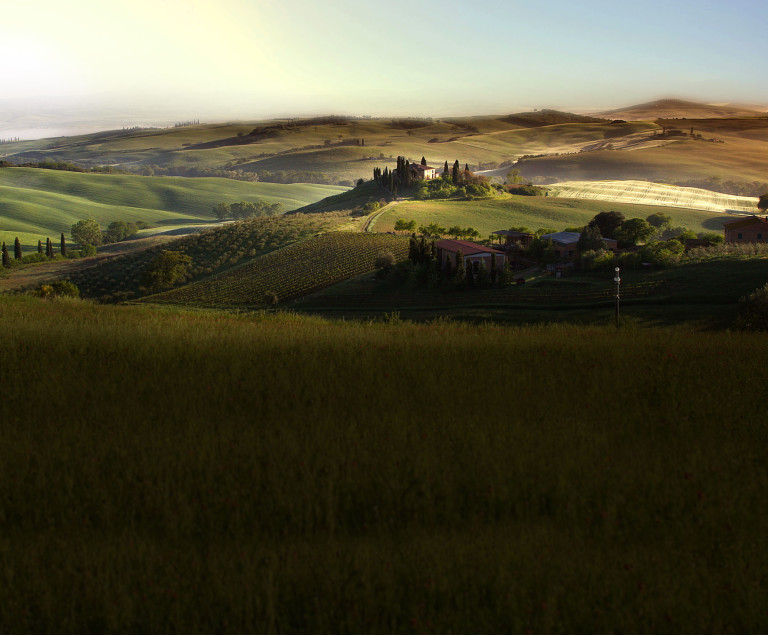Gentle hills, beautiful vineyards and olive groves characterize the landscape around Florence. In fact, with the exception of the heavily built up area to the west of the city, in other directions the abundance of trees and fields makes an immediate visual impact that has become famous worldwide for its wonderful nature and cultural heritage.
History
The geographic area known as Chianti is bounded by the outskirts of Florence to the north and Siena to the south. It straddles those two provinces taking the municipalities of Castellina in Chianti, Gaiole in Chianti, Greve in Chianti and Radda in Chianti in their entirety, and parts of those of Barberino Val d’Elsa, Castelnuovo Berardenga, Poggibonsi, San Casciano in Val di Pesa and Tavarnelle in Val di Pesa.
The earliest documentation of the Chianti wine dates back to the thirteenth century, when the local wine makers and merchants formed the Lega del Chianti (Chianti Alliance) to protect the territory and…the local wine. In 1716 Grand Duke of Tuscany Cosimo III de’ Medici issued an edict legislating that the three villages of the Lega del Chianti (Gaiole, Castellina and Radda) as well as the village of Greve as the only recognized producers of Chianti. This delineation existed until the 1930s when the Italian government expanded the zone. The original area dictated by the edict of Cosimo III de’ Medici would eventually be considered the heart of the Chianti Classico region.
However, it was not until the work of the Italian statesman Bettino Ricasoli that the modern Chianti would take shape. As minister of the interior of the Grand Duchy of Tuscany, Baron Bettino Ricasoli promoted the union of Tuscany with Piedmont, which took place on March 12, 1860. He would later become Prime Minister of unified Italy. It was thanks to him that the modern recipe of Chianti as a Sangiovese-based wine was born.
The wine
The Chianti winegrowing area was established in the late 30’s of the twentieth century by ministerial decree. This is where Chianti Classico is produced.
Chianti Classico is not the same as regular Chianti. It may seem confusing, but it is not. Chianti Classico (or Chianti Classico DOCG) can be produced only in the historic area that comprehends the municipalities above mentioned (Gaiole, Castellina and Radda). Regular Chianti (or Chianti DOCG) comes from a wider area including much of central and northern Tuscany.
And being the grape highly responsive to the environment (soil and climatic conditions) there are a number of sub-zones for the production of Chianti, since the terrain is crucial in determining the distinctiveness of the wines.
The modern delimitation of the production areas dates to a ministerial decree of 1932. The wines produced in the surroundings of Florence includes Chianti Colli Fiorentini DOCG (hills circling Florence), Chianti Montespertoli DOCG (south-west of Florence), Chianti Montalbano DOCG (about 20 kilometres west of Florence), Carmignano DOCG (province of Prato), Chianti Rufina DOCG (produced in the valley of the river Sieve), Pomino DOC (a small part of the municipality of Rufina, once territory of the famous Albizi and Frescobaldi families), Bianco dell’Empolese DOC (white wine produced in the south east corner of the province of Florence), Colli dell’Etruria DOC (covering the same area as Chianti) and IGT wines (known as Super Tuscans). Last but not least the delicious dried grape wine called Vin Santo, a traditional dessert wine, available in very limited quantities.
But there’s something even more interesting to know.
According to the appellation regulations, Chianti Classico DOCG requires a minimum of 80% of Sangiovese red grape, to which other authorized red grape varieties can be added (often Canaiolo Nero, Colorino). White grapes were excluded from the blend in 2006. But they can still be mixed into the blend with Sangiovese to make Chianti DOCG. Moreover, as for Chianti Classico, other quality-improving criteria concern the maximum permitted grape production per hectare and the average yield per vine.
Since its foundation in 1924, the symbol of the Consorzio del Chianti Classico has been a black cockerel, the Gallo Nero, that was also the emblem of Chianti 14th century military league.
Tourist itineraries
The Chianti Classico area is rich in history, dotted with small villages, castles and old churches. A guided tour of Chianti would start south of Florence with the Chiantigiana road that crosses the entire area passing through the historic Chianti region and finally reaching Siena. The road is crisscrossed by a network of smaller roads that connect the larger towns to the many villages and castles (like the Brolio Castle, where Bettino Ricasoli dictated the modern recipe of Chianti wine).
The small towns, thanks to their relaxing mood, are perfect for an afternoon stroll, food shopping and wine tasting.
As for art, much of the artistic legacy is visible in the many museums like the one in Greve or San Casciano. Moreover many are the old churches tucked away among the green hills, concurring to draw a breathtaking landscape just like in a Renaissance painting.
Vocabulary
DOC – DOCG: The designation of origin of a wine denotes the geographical name of a winegrowing zone and designates a fine wine. There are two categories: DOC (Controlled designation of origin) and DOCG (Controlled and Guaranteed Designation of Origin), the latter having more restrictive viticultural and oenological regulations.
IGT: It is another classification of wines recognized by the government of Italy. The IGT label specifies the geographical name of a zone used to designate the product and which has qualities and characteristics attributable to the area in question.






Comments